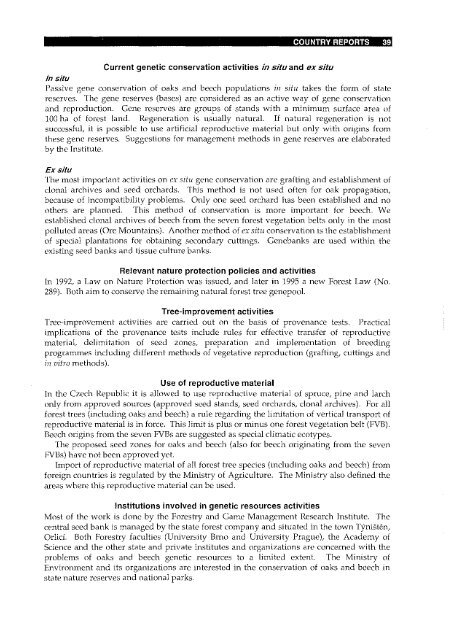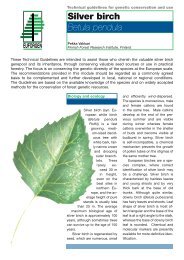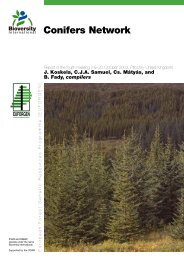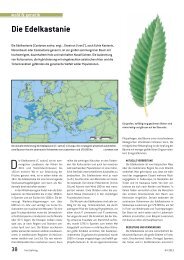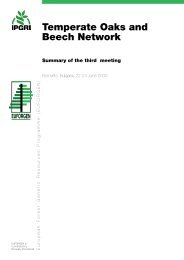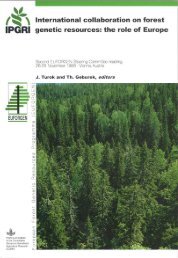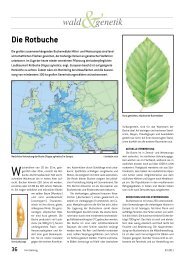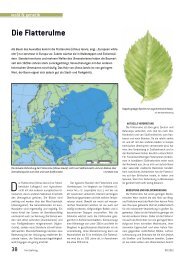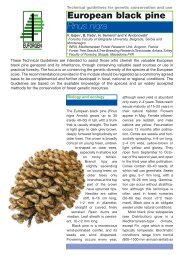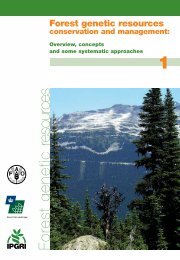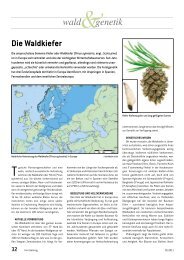Download PDF - Euforgen
Download PDF - Euforgen
Download PDF - Euforgen
Create successful ePaper yourself
Turn your PDF publications into a flip-book with our unique Google optimized e-Paper software.
- G0llJNmBM BEB0SmS 39<br />
Current genetic conservation activities in situ and ex situ<br />
In situ<br />
Passive gene conservation of oaks and beech populations in situ takes the form of state<br />
reserves. The gene reserves (bases) are considered as an active way of gene conservation<br />
and reproduction. Gene reserves are groups of stands with a minimum surface area of<br />
100 ha of forest land. Regeneration is usually natural. If natural regeneration is not<br />
successful, it is possible to use artificial reproductive material but only with origins from<br />
these gene reserves. Suggestions for management methods in gene reserves are elaborated<br />
by the Institute.<br />
Ex situ<br />
The most important activities on ex situ gene conservation are grafting and establishment of<br />
clonal archives and seed orchards. This method is not used often for oak propagation,<br />
because of incompatibility problems. Only one seed orchard has been established and no<br />
others are planned. This method of conservation is more important for beech. We<br />
established clonal archives of beech from the seven forest vegetation belts only in the most<br />
polluted areas (Ore Mountains). Another method of ex situ conservation is the establishment<br />
of special plantations for obtaining secondary cuttings. Genebanks are used within the<br />
existing seed banks and tissue culture banks.<br />
Relevant nature protection policies and activities<br />
In 1992, a Law on Nature Protection was issued, and later in 1995 a new Forest Law (No.<br />
289). Both aim to conserve the remaining natural forest tree genepool.<br />
nee-improvement activities<br />
Tree-improvement activities are carried out on the basis of provenance tests. Practical<br />
implications of the provenance tests include rules for effective transfer of reproductive<br />
material, delimitation of seed zones, preparation and implementation of breeding<br />
programmes including different methods of vegetative reproduction (grafting, cuttings and<br />
in vitro methods).<br />
Use of reproductive material<br />
In the Czech Republic it is allowed to use reproductive material of spruce, pine and larch<br />
only from approved sources (approved seed stands, seed orchards, clonal archives). For all<br />
forest trees (including oaks and beech) a rule regarding the limitation of vertical transport of<br />
reproductive material is in force. This limit is plus or minus one forest vegetation belt (FVB).<br />
Beech origins from the seven FVBs are suggested as special climatic ecotypes.<br />
The proposed seed zones for oaks and beech (also for beech originating from the seven<br />
FVBs) have not been approved yet.<br />
Import of reproductive material of all forest tree species (including oaks and beech) from<br />
foreign countries is regulated by the Ministry of Agriculture. The Ministry also defined the<br />
areas where this reproductive material can be used.<br />
Institutions involved in genetic resources activities<br />
Most of the work is done by the Forestry and Game Management Research Institute. The<br />
central seed bank is managed by the state forest company and situated in the town TyniSten,<br />
Orlici. Both Forestry faculties (University Bmo and University Prague), the Academy of<br />
Science and the other state and private institutes and organizations are concerned with the<br />
problems of oaks and beech genetic resources to a limited extent. The Ministry of<br />
Environment and its organizations are interested in the conservation of oaks and beech in<br />
state nature reserves and national parks.


